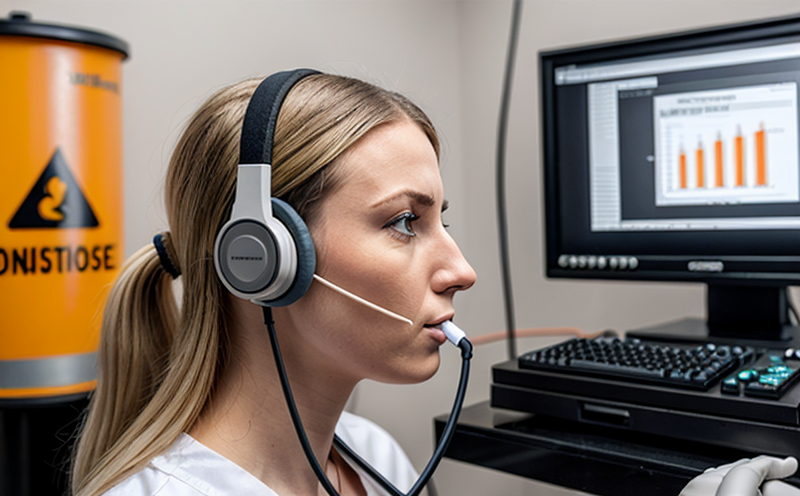CSA Z107.56 Measurement of Noise Exposure in Workplaces
The CSA Z107.56 standard is a critical tool for assessing occupational noise exposure and ensuring workplace safety. This service focuses on the measurement of noise exposure levels, which are essential parameters for preventing hearing loss in workers exposed to hazardous noise environments.
The primary objective of this service is to ensure compliance with CSA Z107.56 and other relevant standards such as ISO 1999:2007, which provide guidelines for the measurement techniques used in industrial noise measurement.
The standard defines a series of procedures to measure sound pressure levels at workers' ears or head, taking into account the duration and intensity of exposure. It is designed to help employers identify hazardous noise environments and implement appropriate controls, such as hearing protection devices (HPDs) or administrative controls like job rotation or time limitation.
The service covers various types of workplaces where noise levels may exceed safe limits, including manufacturing plants, construction sites, music venues, and airports. The standard ensures that workers are protected from the adverse effects of noise exposure by providing a reliable method to quantify noise levels in the workplace.
Compliance with CSA Z107.56 is mandatory for employers in Canada. This service provides comprehensive support to ensure that workplaces meet these regulatory requirements, thereby protecting employee health and safety.
| Parameter | Description |
|---|---|
| Spectral Distribution | Measurements are conducted across the frequency range relevant to human hearing, typically from 20 Hz to 16 kHz. |
| Time Weighting | A time weighting filter is used to simulate the response of the human ear to different sound pressure levels over time. |
| Duration | The measurement period should represent a typical working day, including breaks and other activities. |
Our experienced team uses state-of-the-art equipment that adheres strictly to the standard's requirements. This includes sound level meters (SLMs) with appropriate calibrations and personal dosimeters for accurate noise exposure assessments. Our technicians are trained in the application of these instruments, ensuring reliable data collection.
Applied Standards
The measurement of noise exposure in workplaces is governed by several international standards that provide guidelines for the methods used to quantify and report sound levels. These include:
- ISO 1999:2007 – Industrial noise – Measurement techniques
- CSA Z107.56 – Occupational Noise Exposure and Hearing Protection Testing
- EN 389:2004 – Acoustics – Measurement techniques
- IEC 61252-14 – Personal sound level meters and personal noise dosimeters
The standards provide a framework for the measurement of noise exposure in various types of workplaces. Compliance with these standards ensures that employers are meeting regulatory requirements and protecting workers from the harmful effects of excessive noise.
Scope and Methodology
The scope of our service includes conducting comprehensive noise exposure assessments using the methodologies prescribed by CSA Z107.56 and other relevant standards. Our team follows a structured approach to ensure that all aspects of the measurement are conducted accurately and reliably.
The methodology involves several key steps:
- Site Survey: Conduct an initial survey of the workplace to identify potential noise sources and areas where workers may be exposed to high levels of noise.
- Instrument Calibration: Ensure that all measurement instruments are calibrated according to manufacturer specifications. This step is critical for obtaining accurate data.
- Data Collection: Collect sound pressure level (SPL) readings at the worker's ear or head using personal dosimeters and SLMs, ensuring compliance with time weighting and spectral weighting requirements.
- Analysis: Analyze the collected data to determine the noise exposure levels in decibels (dB). This involves calculating various metrics such as sound level, equivalent continuous noise level (LEq), and peak sound pressure level (SPLpeak).
- Reporting: Prepare a detailed report summarizing the results of the measurement. The report includes recommendations for reducing noise exposure where necessary.
The service also involves training workers on the use of hearing protection devices (HPDs) and providing guidance on administrative controls to reduce noise exposure in the workplace.
Competitive Advantage and Market Impact
- Avoiding Regulatory Penalties: Compliance with CSA Z107.56 helps employers avoid fines and other penalties associated with non-compliance.
- Enhanced Employee Health: By identifying and mitigating noise hazards, this service contributes to a healthier work environment, reducing the risk of hearing loss.
- Increased Productivity: Workers in quieter environments are often more productive. Reducing noise exposure can lead to improved performance and job satisfaction.
- Sustained Compliance: Our expertise ensures that workplaces remain compliant with evolving standards and regulations, providing long-term benefits.
The demand for this service is driven by increasing awareness of occupational health risks and the need for regulatory compliance. Employers in various sectors, including manufacturing, construction, and entertainment, are particularly focused on maintaining a safe work environment for their employees.





